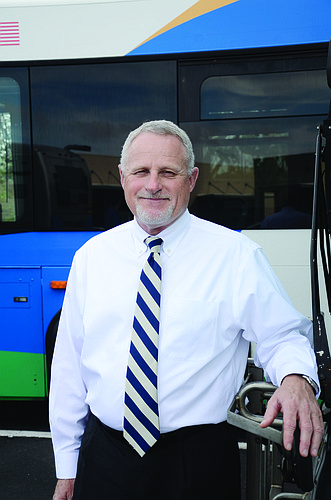- April 16, 2024
-
-
Loading

Loading

Like many people, Rocky Burke made a list of goals he wanted to accomplish in the new year. But, as the new director of Sarasota County Area Transit, Burke’s goals are more far-reaching than most.
The former general manager of Lextran, the public transit system of Lexington, Ky., started Dec. 29 and spent his first week meeting with members of the department and with Tom Harmer, county administrator.
But Burke is anxious to start on his list of goals. Topping that list is completing a comprehensive operations analysis of the transit system. The analysis, which will be completed by an outside firm, will review the transit system to pinpoint which areas of SCAT work well, and which ones require change.
The firm, which has not yet been selected, will survey both riders and non-riders to see what riders want and how the system could increase ridership.
In addition, the analysis will examine the system’s routes to make sure they’re efficient and meeting riders’ needs.
The study could also provide data on topics of ongoing discussion for SCAT.
In the past, the county commission has inquired about privatizing the transit service, an option it decided to move forward with in 2014 for its paratransit system.
Another area of commission discussion is whether the downtown transfer station on Lemon Avenue and First Street is in the best location in terms of efficiency and rider need. Burke said the analysis will examine this.
Burke said he hopes to move the study forward within the next six months. Once started, he estimates it will take nine to 12 months.
Burke takes the helm at a time of transition for the transit system. Five months ago, the county fired the previous director, Glama Carter.
Carter, who held the position since August 2012, received positive scores on her last evaluation and a 3% pay increase in November 2013 but was fired in July. The county did not disclose the reason for her termination. Rob Lewis served as the interim director until December. Burke will receive the same $103,000 annual salary as Carter.
Burke landed the director position over 36 other candidates.
At Lextran, Burke was noted for increasing ridership by 15%. He said two of his biggest achievements in his former role were installing an old-style trolley service in downtown Lexington and starting a program called Arts in Motion. The latter was a collaborative effort with the arts community to beautify the bus shelters with original art and sculptures. The contest resulted in special designs for seven shelters. The transit system also organized a gallery hop once a month and bused people around town to the city’s art galleries.
With the prominent arts community in Sarasota, Burke said he hoped to get similar programs started here.
Installing additional bus shelters and benches will be a priority in the coming year, he said. Not all of the stops in the county have a place to escape from the weather.
“Having amenities for riders is extremely important,” he said. “We need to make sure we budget for them.”
Burke is focused on other goals as well, such as trying to connect SCAT with transit systems in other counties and reviewing bid proposals for outsourcing the county’s paratransit service.
“I’m really energized,” he said. “We’re all one team.”
FACTS FOR '15
The issue: After a five-month search Sarasota County hired a new Sarasota County Area Transit director.
Why you should care: SCAT is scheduled to undergo an operational analysis, and Rocky Burke hopes to get that analysis moving forward within six months.
What’s next: Besides examining the system, Burke will propose some new ideas for increasing awareness of Sarasota’s transit system.
SCAT Snapshot
SCAT currently operates under a $28.5 million budget and averages 2.8 million riders a year. It had 260 employees and 32 fixed routes in 2014.